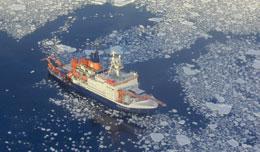Space may be the final frontier, but scientists who recently discovered a hidden forest in Mozambique show the uncharted can still be under our noses. Scientists used Google Earth to identify a remote patch of pristine forest. An expedition to the site discovered new species of butterfly and snake, along with seven Globally Threatened birds.
The team were browsing Google Earth – freely available software providing global satellite photography – to search for potential wildlife hotspots. A nearby road provided the first glimpses of a wooded mountain topped by bare rock. However, only by using Google Earth could the scientists observe the extent of woodland on the other side of the peak. This was later discovered to be the locally known, but unmapped, Mount Mabu. Scientific collections and literature also failed to shed light on the area.
“This is potentially the biggest area of medium-altitude forest I’m aware of in southern Africa, yet it was not on the map”, related Jonathan Timberlake from the Royal Botanic Gardens, Kew (RBG Kew), who led the expedition. “Most Mozambicans would not even have recognised the name Mount Mabu.”
Many New Species Discovered In Hidden Oasis With Help Of Google Earth
Sat, 31 Jan 2009 05:00:00 GMT







 Yavne, Israel (SPX) Jan 29, 2009 - An Israeli company called AORA has developed the world's first modular Hybrid Solarized Gas Turbine Power Station to provide affordable and customizable green energy solutions around-the-clock.
Yavne, Israel (SPX) Jan 29, 2009 - An Israeli company called AORA has developed the world's first modular Hybrid Solarized Gas Turbine Power Station to provide affordable and customizable green energy solutions around-the-clock.
 Chicago IL (SPX) Jan 26, 2009 - While the harsh winter pounding many areas of North America and Europe seemingly contradicts the fact that global warming continues unabated, a new survey finds consensus among scientists about the reality of climate change and its likely cause.
Chicago IL (SPX) Jan 26, 2009 - While the harsh winter pounding many areas of North America and Europe seemingly contradicts the fact that global warming continues unabated, a new survey finds consensus among scientists about the reality of climate change and its likely cause. 



 Abu Dhabi, United Arab Emirates (UPI) Jan 20, 2009 - A renewable energy "revolution" is taking place in the heart of the global oil industry here on the Arabian Peninsula, where world leaders and experts at a summit on tomorrow's energy say it may not only save the climate but also help revive today's ailing global economy. (e-mail:
Abu Dhabi, United Arab Emirates (UPI) Jan 20, 2009 - A renewable energy "revolution" is taking place in the heart of the global oil industry here on the Arabian Peninsula, where world leaders and experts at a summit on tomorrow's energy say it may not only save the climate but also help revive today's ailing global economy. (e-mail: 
 Las Vegas NV (SPX) Jan 21, 2009 - Garmin International has introduced ecoRoute, a free software update that helps drivers conserve money and fuel, easing growing pressures on personal budgets and the environment.
Las Vegas NV (SPX) Jan 21, 2009 - Garmin International has introduced ecoRoute, a free software update that helps drivers conserve money and fuel, easing growing pressures on personal budgets and the environment. 















 U.S. scientists say they can turn E.coli, a strain of bacteria present in the human digestive tract, into a fuel that is twice or three times more efficient than ethanol. The scientists, attached to the University of California in Los Angeles (UCLA) managed to create a strain for the first time that generates alcohol with five carbon atoms per molecule instead of the regular two or three. That's important because the larger, longer chain molecules contain more energy, something of a "holy grail" for the fuel industry.
U.S. scientists say they can turn E.coli, a strain of bacteria present in the human digestive tract, into a fuel that is twice or three times more efficient than ethanol. The scientists, attached to the University of California in Los Angeles (UCLA) managed to create a strain for the first time that generates alcohol with five carbon atoms per molecule instead of the regular two or three. That's important because the larger, longer chain molecules contain more energy, something of a "holy grail" for the fuel industry.








